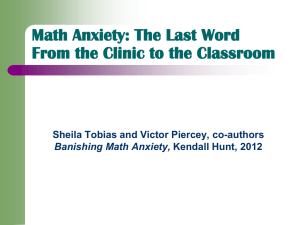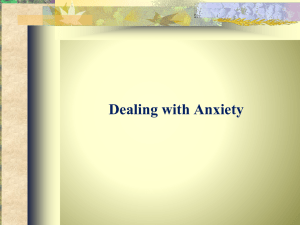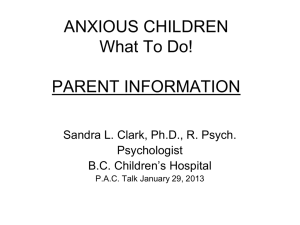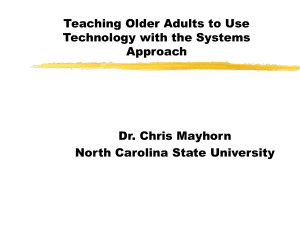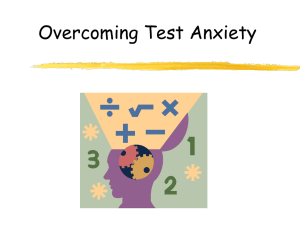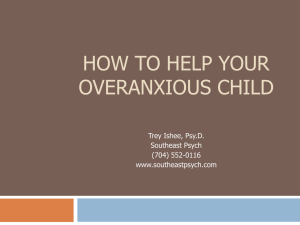here
advertisement
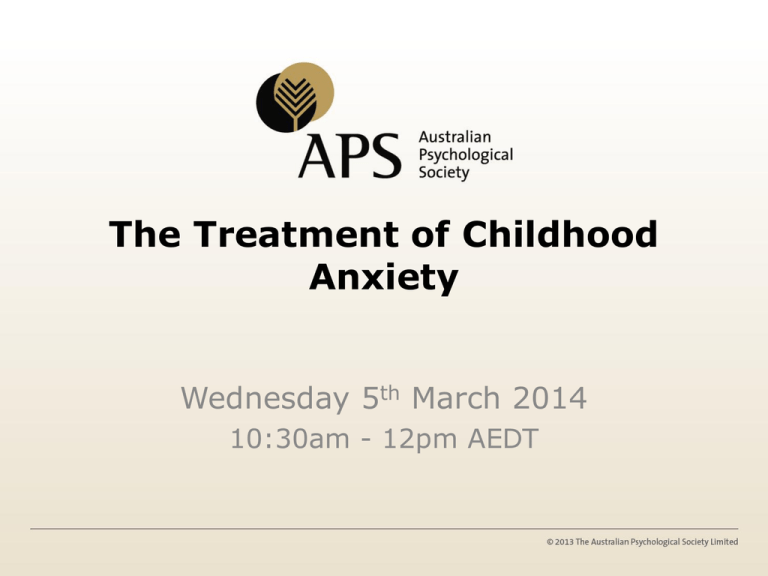
The Treatment of Childhood Anxiety Wednesday 5th March 2014 10:30am - 12pm AEDT Before we start… • Ensure sound is on and volume turned up on your computer. • If you are experiencing problems with sound, dial in using your telephone as per details on your confirmation email (enter telephone number and password provided). • Dial 1800 733 416 for technical support (Redback). • Specific question/s may be asked throughout the webinar using the chat box - presenters will endeavour to answer them at the end of the webinar. PRESENTERS: Prof Ronald M Rapee Centre for Emotional Health Macquarie University Carol Woolcock Child and Adolescent Psychotherapist and Social Worker Facilitator: Harry Lovelock, Senior Executive Manager APS Treatment of anxiety in young children Ronald M Rapee Centre for Emotional Health Macquarie University Who is this treatment for? • Children with a clinical anxiety disorder – – – – – Separation anxiety Social anxiety Generalised anxiety Obsessive compulsive Phobias • Anxiety is primary problem • Out of proportion to age and context Characteristics of empirically-validated treatment for child anxiety • Individual (or group) sessions delivered by highly qualified therapist • 10-16 Sessions; ~ 60 min. • “CBT” – Education; Anxiety management (relaxation, cognitive restructuring); Exposure; Additional skills (problem solving, assertiveness, social skills, parenting). • May or may not include parents • Suitable for primarily anxious children; • aged 7-15 REMISSION OF ANXIETY DIAGNOSIS ACROSS ALL STUDIES IN TWO REVIEWS % DXFREE JAMES ET AL (2005) CARTWRIGHT-HATTON ET AL, 2004 Meta-analyses of treatments for child anxiety Reynolds et al 2012 1 0.8 E.S 0.6 0.4 0.2 0 CBT vs control non-CBT vs control Note – Child self report CBT vs Passive control CBT vs Active control A detailed example the Cool Kids program The Cool Kids Program Overview • Based on 18+ years of treatment outcome research • Uses a skills-based approach • Three age versions – Preschool – Primary school – High school • Three delivery versions of the program – Family/Community Version – School Version – Outreach Version • Specific Populations – – – – Standard Anxiety/Depression High Functioning Autism TBI The Cool Kids Program - FEATURES • • • • • • 10 sessions/ 12 weeks Ages 7-17 Parents included Any/ all anxiety diagnoses Workbooks – therapist, parent, child Groups – – – – – 4-7 / age related Diagnoses combined Approx 2 hours Two therapists Together – separate - together Does Cool Kids work? COMPARISON WITH PLACEBO HUDSON ET AL (2009) • • • • 112 CHILDREN AGED 7-16 BROAD-BASED ANXIETY DISORDERS RANDOMLY ALLOCATED TO GROUP CBT (GCBT) – COOL KIDS • GROUP SUPPORT & ATTENTION (GSA) – SUPPORTIVE ENVIRONMENT, INFORMATION ABOUT EMOTIONS, BUILDING RELATIONSHIPS Hudson, J. L. et al (2009). Journal of the American Academy of Child and Adolescent Psychiatry, 48(5), 533-544. Features of Children • Age ~ 10 yr • Approx 45% female • Primary dxs – GAD ~ 50% – Social ~ 20% – SAD ~ 15% • Comorbidity – Anxiety ~ 80% – Externalising ~ 15% – Other ~ 5% • N of Comorbid Diagnoses > 2 Primary Anxiety Disorder 100 % no longer meeting criteria for primary anxiety disorder 90 80 70 60 Pre 50 Post 40 3monthFU 30 20 10 0 GCBT GSA Clinical Severity of Primary Anxiety Disorder Clinical Severity Rating Delivering treatment to children aged 7-12 Who to include? Principal diagnosis of anxiety (?) Any anxiety disorder (PTSD?) Aged 7 and up Encourage both parents (need to consider childminding, time) • Step parents, separated? • • • • The Cool Kids Program Content • Psycho-education • Cognitive restructuring (Detective thinking) • Child management • In vivo exposure (plus rewards) • Skills training Cool Kids Program – Session outline 1 • Session 1: What, Why and How? – Practice tasks: Children: Linking thoughts and feelings – Parents: Monitoring aspects of the child’s fears and worries • Session 2: Learning to Think Realistically – Practice tasks: Children: Detective Thinking – Parents: Cognitive Restructuring • Session 3: Parenting an Anxious Child – Practice tasks: Children: Detective thinking and self reward monitoring – Parents: Monitoring of parent management strategies Cool Kids Program – Session outline 2 • Session 4: Fighting Fear by Facing Fear – Practice tasks: Children: Perform the first steps as planned. – Parents: Record details of steps and difficulties encountered. • Session 5: Creative Exposure – Practice tasks: Children: Completing Steps and using Worry Surfing – Parents: Monitor steps and difficulties faced. • Session 6: Identifying Problems and Difficulties – Practice tasks: Children: Completing Steps – Parents: Monitoring Steps and Assessing Social Skills Cool Kids Program – Session outline 3 • Session 7: Social Skills and Assertiveness – Practice tasks: Children: Assertiveness checklists and completing steps – Parents: Monitoring steps and providing opportunities to practice assertiveness • Session 8: Sustaining Progress – Practice tasks: Children: Completing Steps – Parents: Monitoring Steps • Session 9: Reviewing Goals and the Final Push – Practice tasks: Children: Completing steps. – Parents: Monitoring steps. • Session 10: Maintaining Gains and Coping with Set-Backs – Practice tasks: Setting and implementing long term goals An example Exposure for separation fear Developing exposure hierarchies Explain principles through examples Explain methods and procedures Brainstorm avoided situations Organise into related groups Arrange in order of difficulty and brainstorm additional steps • Add rewards • • • • • STEP BY STEP PLAN Lashi’s Goal: to be able to stay at home with a sitter without worrying about Mum being out STEP 1: Staying home with Dad while Mum goes out for 10 Minutes. Reward: Extra Story when I go to bed_ STEP 2: Staying home with Grandma for 30 minutes Reward: Choose what we have for dinner STEP 3: Staying home with dad while Mum goes out for the afternoon Reward: Go bike riding with Mum STEP 4: Stay home with Grandma all day Reward: Choose activity for Mum and I to do STEP 5: Stay home with a sitter in the afternoon Reward: Stay up a half-hour later than normal STEP 6: Stay home with a sitter for the day Reward: Mum will bring home a surprise STEP 7: Stay home with Dad while Mum goes out for the evening Reward: Have a friend over for dinner STEP 8: Stay home with Grandma while Mum goes out till late at night Reward: Go to Dinner at a restaurant STEP 9: Stay home with a sitter for a few hours in evening Reward: Have a few friends over to sleep for night STEP 10: Stay home with a sitter while Mum goes out for the night Reward: Go to Sega World with two friends Delivering treatment to children aged 3-6 The Cool Little Kids program Structure of sessions • Research format is run in groups (can be individual) • Approx. 120 mins per session (individual standard session) • Parents only – both parents (or main caregivers) strongly encouraged to attend • Program 12 weeks/ 6 sessions (sessions 1-2 weekly, sessions 3-5 fortnightly, session 6 booster after month) • Clinical severity – more sessions • Combination of didactic presentation with therapeutic reflection & understanding Cool Little Kids – Session Outline 1. 2. 3. 4. Psychoeducation and motivation Management of parent overprotection Graded exposure to child’s fears Troubleshooting exposure & dealing with parent anxiety – especially related to exposure and overprotection 5. Troubleshooting exposure & dealing with parent anxiety 6. Review of strategies & discussion of future Centre for Emotional Health Emotional Health Clinic PHONE: 02/ 9850-8711 www.centreforemotionalhealth.com.au I KNOW IT’S JUST THEIR HABITAT BUT PLEASE DON’T BUG ME! Treatment of a 9 year old boy PRESENTATION James 9 years old 2 month history of extreme fear of bugs Previously ‘loved’ bugs and had a collection of plastic bugs but has insisted they be placed in the rubbish • Symptoms of avoidance, “hysterical” crying, hyperventilation, sweating, sleep disturbance • Predicts he won’t attend school in term 4 as the topic of investigation is BUGS • • • • Family Background • Resides with both parents • Has a physical condition that requires regular medical treatment • Recent criticism of James and his mother by the medical team for “Not trying hard enough” ASSESSMENT • Assessment limited to current situation obtained from initial session with parents • Developmental history and family history obtained during previous contact with the family • Cognitively in average range • Receptive and expressive language a strength • Attends mainstream primary school • Good peer relationships • No behavioural concerns Diagnosis • Does not meet the full DSM IV TR criteria for Specific Phobia as of less than 6 month duration • Meets the ICD10 diagnostic criteria for Specific (isolated) phobia • Does not meet the diagnostic criteria for any other Mood Disorder Treatment Plan • Systematic desensitization • Six one hour sessions, Monday, Wednesday and Friday during the school holidays • Homework after each session to consolidate • Mother to sit in during sessions • Parents to address conflict with medical team Overview of sessions 1. 2. 3. 4. 5. 6. Establish contract with James Relaxation techniques Establish hierarchy of fears Introduce drawings & photos of least feared Introduce drawings & photos of most feared Maintenance plan, celebration Session 1. Contract • Reconnect. What’s happening in his life • Why has he come to see me? • Establish that James would like to be free of fears • Impact that the fears have on his life • Permission given to CW to name and talk about bugs • Agreement that I would never show him a live bug CONSIDERATIONS • Importance of building rapport with the child (& the parent/carer) • Children do not always recognise that the fear is excessive or unreasonable so not essential for acknowledgement for treatment to begin • Can ask questions such as “Who is most concerned?” • Important for the child (& parent/carer) to be a willing partner in the treatment Session 2. Relaxation • Establish current physical symptoms • Instruct James on relaxation techniques. He asked that his mother joined in so she could learn to relax too. • Self talk • Decide on a special word that he/mother could say to initiate relaxation (James asked mother to nominate one for herself) • Homework: practise relaxation when fears not present CONSIDERATIONS • Children may not be able to describe all their physical or emotional symptoms and parents/carers can be helpful in describing what they have noticed about their child. Session 3. Hierarchy of fears • • • • • • • • Establish list from least to most concerning Ants Beetles Flies Butterflies Mosquitoes Spiders What is his fear about each one? CONSIDERATIONS • Important at this stage to accept what the child is telling you about what they fear even if it seems insignificant to you. E.g. ants might crawl on you. Asking what would happen then may lead to voicing the fear that ants might crawl into his eyes, mouth, nose, etc. • Check if the child has had any adverse experiences with bugs • Acknowledge the need to be cautious about some bugs. Session 4. Introduce drawings & photos of ants • Discuss the plan for the session & gain agreement to proceed • Allow James to decide on proximity • Choose drawing that are non-threatening e.g. humorous cartoons from clip art. • Check for physical symptoms • Use relaxation techniques • Progress to more explicit drawings • Praise • Provide non threatening photos of ants • Homework: He can keep the drawings & photos, show them to dad and colour in if he likes CONSIDERATIONS • Need to take care not to overwhelm the child with too much visual material this session • Explain each drawing, check proximity required. Expect maximum distance for the first few. Present one at a time, explaining each beforehand. Session 5. Introduce drawings & photos of spiders • Discuss the plan for the session & gain agreement to proceed • Allow James to decide on proximity for each item • Choose drawings that are non-threatening e.g. humorous cartoons from clip art. • Check with him for symptoms • Use relaxation techniques • Progress to more explicit drawings • Praise • Provide non threatening photos of spiders • Homework: He can keep the drawings & photos, show them to dad and colour in if he likes CONSIDERATIONS • It’s a huge leap from least to most feared • Talk about the bugs in between the two extremes • If more sessions available can focus on more of the bugs in the hierarchy. E.g. if 8 sessions available could include beetles and butterflies Session 6. Maintenance and Celebration • Discuss returning to school and how he will manage the topic for the term • Praise • Review relaxation techniques • Where to from here? • Replace his plastic bugs? • Look at live bugs e.g. in a jar? • When is it OK to handle bugs? • When it is wise to avoid bugs? CONSIDERATIONS • A rehearsal of how he will negotiate the topic with his teacher can be useful • Allow the child to set the pace in respect to replacing his plastic bugs or viewing live bugs in a jar. • Convey a healthy respect for venomous bugs Concurrent intervention • Discussion with parents re criticism by medical team. Parents decided to arrange a meeting with the team leader to voice their concerns, particularly the negative impact on James. • As the parents believe the criticism is unfounded they would like the team leader to convey to James how pleased his is with James's efforts. CONSIDERATIONS • Often there is no clear cause for the development of a phobia and assessment should take into consideration not only child factors but explore environmental factors and family characteristics. QUESTIONS & ANSWERS REMINDERS • Contact The ATAPS CMHS Clinical Support Service. Phone on 1800 031 185 or email clinicalsupport@psychology.org.au • Another webinar in 2 weeks time on the 19th March (1:30-3pm) The Treatment of Emotional Disorders in High Functioning Autism. Two further CMH webinars will be organised in the coming months – See the ATAPS Clinical Support Service web portal. • A recording of this webinar will be available on the APS ATAPS Clinical Support Service web portal - see http://www.psychology.org.au/ATAPS/networking_CMHS/ • Please complete the Exit Survey – your feedback is appreciated! • Thank-you for your participation and we hope you enjoyed it.


